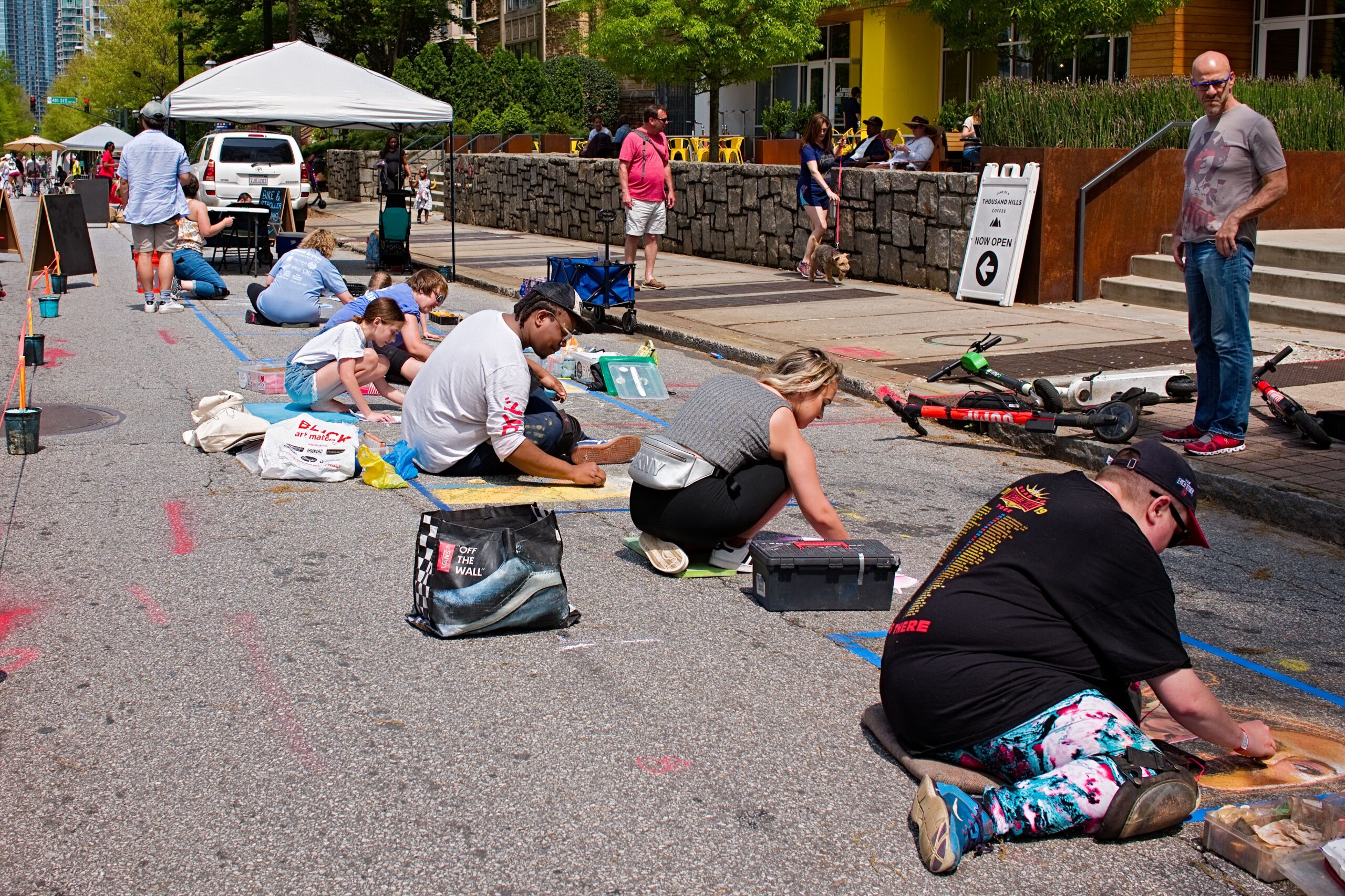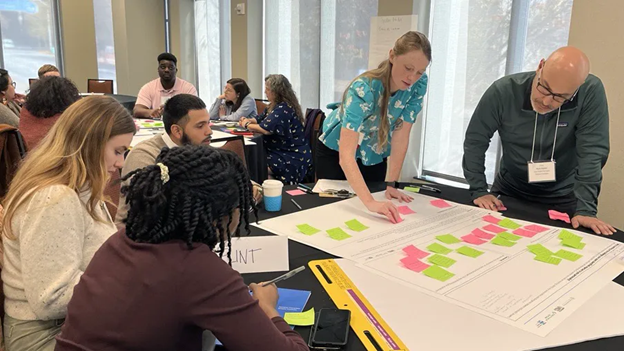
When you hear “infrastructure,” most people naturally think of the physical built environment — roads, bridges, buildings. There’s a lot less emphasis on other kinds of infrastructure that are equally as important, like civic infrastructure.
Civic infrastructure encompasses a broad range of community assets, going beyond the purely physical to also include, for example, the existing culture of a community, the robust networks that have a shared stake in building beneficial infrastructure, and how stakeholders engage and work together. Prioritizing civic infrastructure recognizes that relationship building, community engagement and collaboration can be as important as physical construction. To make their physical infrastructure dreams reality, local communities need a civic infrastructure that supports their long-term capacity.
As communities around the world work to reconnect, prioritizing civic infrastructure alongside physical infrastructure represents a shift from the status quo — from project-based and government-led to community-based and collaborative. Instead of a top-down approach, in which government authorities dictate what communities need, cities are embracing a new approach that respects community wisdom while receiving the support and resources needed to realize their plans and aspirations.
This new approach underpins Community Connectors, an initiative funded by the Robert Wood Johnson Foundation that supports government and community collaborations in small and mid-sized U.S. cities to advance locally-driven projects that will reconnect communities separated or harmed by transportation infrastructure. In 2023, 15 teams from communities across the U.S. were selected to join a cohort of peers, practitioners and other cities as they work to advance their local infrastructure projects over the next two years. These teams also will receive capacity-building grants and technical assistance for their projects.

The 15 projects selected for the Community Connectors program are designed to be intersectional, addressing challenges that reach across transportation, housing, safety, jobs, economic development, placemaking and more. These projects also call for building broad collaborations, aligning values and goals, leveraging the support and resources of local and state partners, and sourcing experiences and lessons learned on topics like zoning and land trusts.
Below, we take a closer look at capacity building and technical assistance: what they mean, why they are crucial tools for success and what types of assistance, processes and tools they require.
Technical Assistance vs. Capacity Building
First, let’s define some terms:
Technical assistance is the process of providing targeted support to an organization with a specific development need or problem.
Capacity building is a type of assistance that includes training and building skill sets for organizations to meet needs on their own and reach a level of operational, programmatic, financial or organizational maturity to effectively advance towards their goals.
Both technical assistance and capacity building are crucial tools for implementing each community’s project, sustaining momentum and ultimately achieving the vision set out in each effort so that community members realize the benefits. They can help communities overcome burdens that may scuttle projects before they even start or limit their ongoing participation and oversight of implementation, such as access to resources, funding and expertise on specific topics.
As part of the application process, and then again during an in-person convening in Atlanta, Georgia, the 15 communities in the Community Connectors grant program identified short- and medium-term technical assistance and capacity-building needs. Many of these needs will be met by team members from the organizations leading the program, including Smart Growth America, Equitable Cities, America Walks and the New Urban Mobility Alliance (NUMO). Others can potentially be addressed through broadened local partnerships.
What Types of Technical Assistance Do Communities Need?
1) Identification of Available Funds to Reconnect Infrastructure Projects
The grants the 15 communities get through the program are just part of their communities’ infrastructure journeys. The goal of the program is to support each community in developing their projects so that they can create a competitive application for discretionary grant programs and federal funds, including those that are passed through to states and municipal planning organizations.
Identifying and securing these funds can be critical for long-term success, but it can be challenging to know exactly what money is available and from whom. For instance, some funds from the Bipartisan Infrastructure Law have made it possible to tap the four biggest formula highway program funds for broadly defined workforce development, with communities being able to access these funds through state departments of transportation.
2) Development of Funding Proposals
Once you know what funds are available and how to apply for them, it’s time to develop a compelling funding proposal that sets your project, approach and partners apart from the crowd. Having expertise from those who have been there before to help share your project’s narrative, goals and processes will be key to creating a proposal that connects you to funding that can help you meet longer-term needs.
3) Policy and Engineering Advice
Each of the community efforts that are a part of the Community Connectors grant program has a strong, diverse and passionate network of individual advocates, metropolitan planning organizations, school districts, local businesses and many other stakeholders contributing their ideas and knowledge.
But sometimes advice from others is needed, especially in areas like environmental permitting requirements, zoning and land-use laws, affordable housing development and historic preservation, to name just a few. That’s why it is important to get support on specific technical areas from sources with policy and engineering experience.
4) Data Collection and Analysis
Knowing what sort of analyses and data are needed and how to access or gather that data are key to efforts like effective community engagement and communicating how a transformative project could improve health, safety, sustainability and other outcomes for the community.
What Capacity-Building Measures Do Communities Need?
1) Unification of Robust Coalitions of Partners
Each project selected for the Community Connectors grant program is ambitious in scope and expansive in reach. To achieve success, a broad base of diverse partners is needed to advocate for and implement transformative change. That includes foundational partners like local nonprofits, schools, neighborhood associations, community-based organizations and chambers of commerce, as well as partners that are hard to reach, including city governments, philanthropists, charities and private-sector stakeholders.
It’s important to consider how to reach out to each of these potential partners, when to bring them in and in what capacity, to build a strong coalition that ramps up the ambition of the project.
2) Assistance to Build Trust and Address Past Harms
Once trust is broken, it must be earned back. In the case of communities that have been subject to destruction, division and racially-discriminatory policy practices, rebuilding trust is a foundational component of any successful infrastructure project. But that can be easier said than done. These are challenging, but necessary, conversations that must be handled sensitively and with the intention of infusing continued trust-building throughout the entire project process.
3) Support to Nurture Existing Relationships and Establish Shared Values
Of course, bringing together a broad coalition of partners is only the start of building trust and sustaining ongoing relationships. Relationships are built continuously, not all at once, which is why there needs to be thought and practice put into strategies for nurturing relationships during all stages of the project. It is also important to establish a set of shared values that are highly visible so stakeholders have a place to come back to when there are disagreements.
4) Networking Opportunities
Networking, both in-person and virtually, can be a valuable tool to build capacity. Engaging with communities that have completed or are farther along in the process of their own infrastructure projects is a wonderful opportunity to learn from each other, share success stories and problem-solve around specific challenges.
5) Learning Strategies and Best Practices
Communities embarking on intensive, transformative infrastructure projects are eager to learn strategies and best practices on any number of topics, including equitable, inclusive development and anti-displacement; effective, community-centered engagement and communications; building and sustaining long-term momentum, as well as overcoming barriers to that momentum; and how to manage, finance and talk about projects that take place over a long period of time.
There is no one-size-fits-all approach to any of these topics. That is why Community Connectors invites participants to regular learning sessions hosted by guest speakers who have participated in efforts to reconnect communities. They share the ups and downs, what they learned along the way and open the floor for discussion with the participants.
—
These needs aren’t limited to the Community Connectors communities. They’re applicable to a broad range of communities across the globe. Not all efforts, however, have funding to support communities and local governments as they work together to deepen relationships, support participation and ensure an intersectional approach to multifaceted challenges. The capacity-building grants provided by the Community Connectors program aim to bridge that funding gap, and the program will also connect communities to technical assistance opportunities as they work to build the infrastructure that will benefit them and open the door for further collaborations and long-term resilience.
Hosted by WRI Ross Center for Sustainable Cities, NUMO is an alliance organization that channels urban disruptions to build sustainable, just and joyful cities.
Madlyn McAuliffe is Communications Manager for NUMO.
Justyn Huckleberry is Research & Projects Analyst II for NUMO.
Harriet Tregoning is Director of NUMO.








